Joining sheet metal parts is an essential aspect of Sheet metal fabrication. To create the required shapes and geometries, they need to be joined, and the joint should be capable of providing desired strength.
During the manufacturing of sheet metal, various joining techniques are used, including soldering, riveting, brazing, adhesive, and welding. Among these, metal welding & metal riveting are the most common approaches, which are effective for several applications.
In this article, we will briefly discuss the riveting & welding process with their advantages & disadvantages and comparison regarding various aspects.
Riveting Process
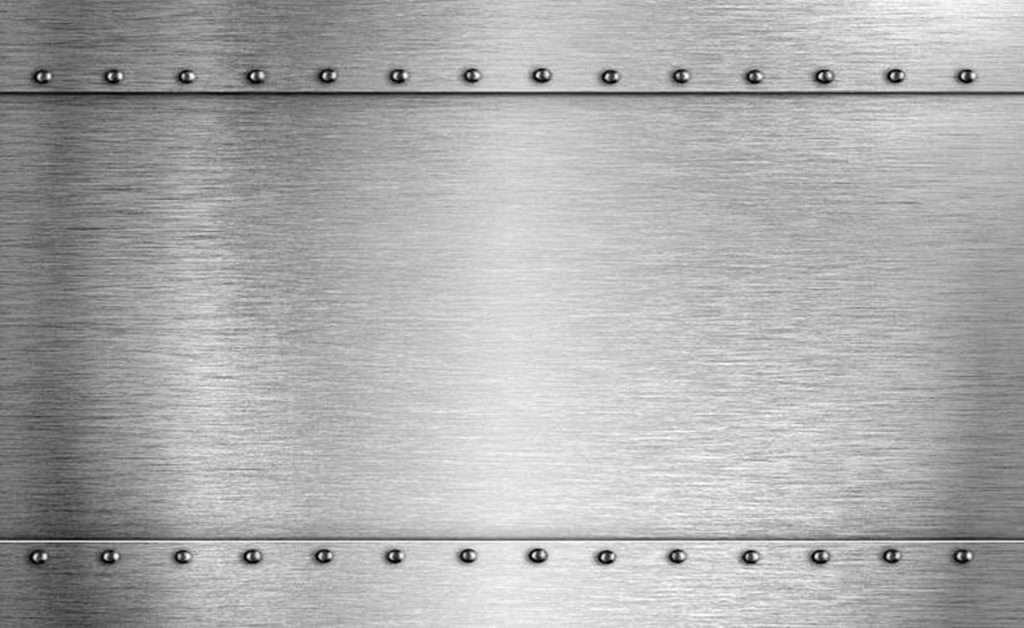
Rivet joints on sheet metal
Riveting refers to the process of joining two or more metal pieces together by creating a series of multiple overlapping holes. Small metal pins are inserted in those holes to bond the metal pieces called rivets. The riveting process is commonly used in the joining of sheet metal pieces.
Once the rivets are in the hole, you must flatten the rivet tail by hammering or smashing the rivets, restricting the removal. The heat is also applied in the riveting process so that the rivets will expand and create strong bonds. It is a quick and robust way to bond between metal pieces by joining them.
In the current era of automated manufacturing, CNC machines do the riveting work with sheet metals, in which holes are created with the CNC drilling process, and also insert the rivets into the holes by computer programming (G-codes). The riveting process is applicable in manufacturing automobiles, aircraft, energy, boilers, and various general appliance parts (Ahmad, 2014).
Types of rivet joints
There are various types of riveted joints, and how you put rivets relies on the type of rivet you use. Let’s take a close look at them.
Based on the placement of rivets
Based on the placement of rivets, there are two types of rivet joints, lap joint & Butt joint.
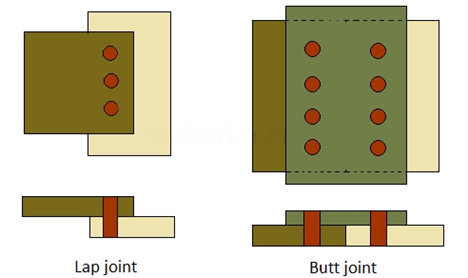
Lap & Butt joint
| Lap joint | Lap joints are created by overlapping two sheet metal pieces and inserting the rivets at the overlap position. You can create single and double joints based on the size of the overlapping position. |
| Butt joint | In the butt joints, additional material is used for the riveting along with the pieces of sheet metal. The other material bridges the sheet metal pieces either of one or both sides before the rivet cover plate. |
Based on how rivets are arranged
Based on the arrangement of rivets, there are two types of rivet joints, chain & Zigzag riveted joints.
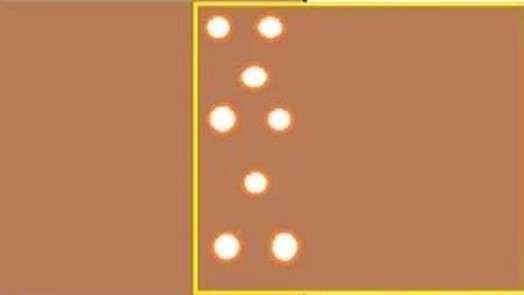
Zigzag rivet joints
| Chain Joint | The joints are called chains when the rivets rows are directly across from other in a straight line. |
| Zigzag joint | .The zigzag joints are not placed opposite to each other and lie in a straight line. They are put in any location of overlapping. |
Based on the cover plate numbers
As you know, riveting can join two or more numbers of sheet metal pieces. There are two types of joints based on the number of plates used in the riveting, single strap & double strap butt joints.
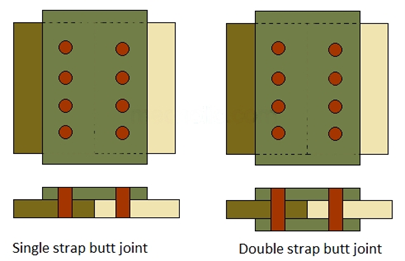
Single & double strap butt joints
| Single strap butt joint | In a single strap butt joint, the major plate is placed next to one another without overlapping, and the cover plates are placed on one side of the main plate. |
| Double strap butt joint | The cover plates are positioned on both sides of the sheet metal pieces in double strap butt joints. |
Advantages of Rivet Joints
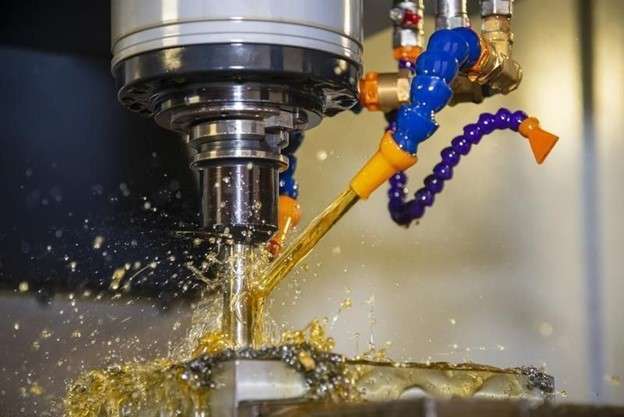
CNC drilling process
1. Less equipment requirement
Riveting uses less equipment and produces less waste than other metal joining approaches, such as soldering and welding. All you need is a rivet gun and a drilling machine.
2. High Productivity
Riveting is a simple process that doesn’t require a complicated setup. You can apply a lot of rivets quickly if you use a CNC machine to operate the riveting process. However, manual riveting could take more time than CNC riveting, but it still takes less time than other metal joining approaches.
3. Design Flexibility
According to the requirements of joining, rivets can be formed into different shapes and sizes. Also, various types of metal can be chosen to create the rivets. Round head, countersunk, Oval countersunk, brazier, tubular, and oval-headed are the most common shapes of rivets. In addition, Rivets can be painted to match the color of the worksheet.
4. Durability
Rivets are strong, corrosion & moisture-resistant, and chemically inert since most of them are made with alloy-based high-strength materials, such as nickel, galvanized steel, and various alloys of aluminum & steel.
5. Cost-effective
Rivets are less expensive than other metal joining approaches. It does not require electricity and specialized equipment, so it saves cost significantly.
Try Prolean Now!
Disadvantages
1. Labor force
The riveting process in sheet metal fabrication requires more human resources to complete the process, even by using CNC riveting. Because it involves drilling holes, hammering tails, and heating to red hot (How to manual riveting, 2016), these steps require proper care with skillful operators.
2. More weight
The high number of rivets in metal parts increases the overall weight. They weigh more weight than the welding joints.
3. Aesthetic beauty
Rivet joints affect the aesthetic beauty of the surface. The head and tails of rivets might disturb the surface finishing joined sheet metal. In addition, rivets are noticeable from a long distance.
Welding Process

Welding process
Welding is one of the dominating approaches of metal joining in the manufacturing of sheet metal. Welding creates the joint by melting similar metals into the joining position. Once the melt pool gets cooled, it forms a rigid joint.
The mating surface of sheet metal is subjected to intense heat and fused the sheets into a single part. Welding is done using welding rods or gases, which need to target joining positions to melt the designated area.
Almost all metals, including steel, stainless steel, aluminum, nickel, copper, titanium, cast iron, and numerous alloys, are suitable for welding.
Types of welding
There are various types of welding used in sheet metal fabrications. Let’s review some of the most popular welding types in more detail.
| Welding Type |
Description |
| TIG |
Tungsten inert gas (TIG) welding uses non-consumable tungsten electrodes, and shielding gas is also used to prevent contamination in the weld pool. The additional filler rod is also required since the electrode is non-consumable. It applies to steel, aluminum, copper, titanium, magnesium, chromium sheets, and steel. TIG is popular in fabricating furniture to advance automotive and aerospace parts. |
| MIG | MIG welding involves heating the sheet metal into the joining position using a consumable solid wire electrode. The welding gun uses shielding gas, such as helium, argon, and nitrogen, which prevents possible contamination from the external environment. |
|
Stick |
Stick welding uses the stick covered in flux as an electrode connected to the negative terminal of the electric source. The sheet gets connected to the positive terminal and when the electrode touches the sheet electric spark creates the weld pool to join the sheets. It works best for rigid metal sheets such as carbon steel and iron. |
| Plasma Arc | As the name implies, plasma arc welding melts the welding spot using a fast-moving plasma stream of ionized gas. The heating of orifice gas generates the plasma, and the operator targets it towards the designated area with constricting nozzle. In addition, shielding gases are also supplied in the welding position. |
|
Laser beam welding
|
Laser beam welding melts the welding spot by using a continuous photon beam. It produces significantly less heat effect as compared to other processes. It is appropriate for joining sheet metal with a high melting point. |
Advantages of welding joints
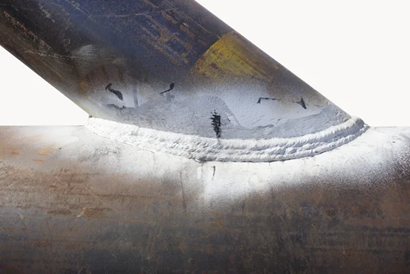
Welding joint
Welding creates strong and permanent joints for the metallic parts. There are various advantages of using welding for joining metal pieces. Let’s discuss some of them in detail.
1. Strong & permanent joints
The welding melts the metal sheets at the joining position and fuses them, which does not allow the splinting over time. They will not leak or fail and will be held very long.
2. Superior strength
The strength of welding joints becomes similar to the parent materials or more. So, it provides superior strength as compared to other joining techniques. In addition, since welding does not affect the original strength, load-bearing capacity will remain unchanged.
3. Enhance the mechanical properties
In welding, a filler rod adds additional materials to the joint, which might enhance the mechanical properties. So, using a filler rod will also help achieve the desired mechanical properties.
4. Light in weight
Welding joints are lighter in weight than other joining processes, such as riveting.
5. Complex geometries
Welding is capable of creating joints in complex geometries. So, it can shape sheet metal into various geometries.
6. Joining of dissimilar materials
Joining dissimilar materials is also possible with welding (Dudeja, 2018). However, you must follow special instructions and take extra care while joining. In most circumstances, a filler rod will be required to connect two dissimilar materials.
Disadvantages

Welding joint
Welding is a great way to create joints on sheet metal parts. However, there are a few drawbacks too.
1. Change in properties
Since sheet metal is melted at the welding position, it might damage the various properties of parts around the heat-affected zone.
2. Stress generation
Simultaneous heating and cooling of sheet metal at the welding position creates undesirable residual stress, which might lower the load-bearing capacity.
3. High vibration
Welded joints tend to vibrate more than other joints, which might cause the failure of the part.
4. Challenging for inspection
It is challenging to evaluate any potential flaws in the welding joints visually. Welding requires advanced equipment for the inspection.
Comparison of Riveting and Welding-Riveting vs Welding
Riveting and Welding. Both have their distinct advantages and limitations. Here, we dive into a detailed comparison of riveting vs welding across various dimensions.
1. Production Speed:
Riveting: Riveting, especially when using sheet metal rivets, is generally faster as it involves mechanically joining sheet metal joints without the need to melt the materials.
Welding: Welding processes often take longer as they involve melting and fusing materials, followed by cooling periods.
2. Material Types:
Riveting: Riveting is versatile, suitable for joining different types of materials, especially when sheet metal joints are involved.
Welding: Welding is mainly used for metals, limiting its application to certain material types.
3. Cost:
Riveting: The process is cost-effective, especially when dealing with large-scale production or when using sheet metal rivets.
Welding: Often, welding can be costlier due to equipment, energy, and skilled labor requirements.
4. Strength:
Riveting: While riveted joints offer decent strength, they might not provide the same uniform strength as welded ones.
Welding: Welded joints, when done correctly, usually boast superior strength since the materials are fused together.
5. Applications:
Riveting: Common in structures that might require disassembling or where vibration is a concern, like in aircraft.
Welding: Preferred in applications demanding high strength and permanence, such as building frameworks.
6. Weight Sensitivity:
Riveting: Sheet metal rivets add extra weight, which might be a concern in weight-sensitive applications.
Welding: Welding doesn’t add significant additional weight, making it suitable for weight-sensitive projects.
7. Aesthetic Appeal:
Riveting: Riveting offers a distinctive appearance, which might be appealing in certain designs but may not offer the seamless look of welding.
Welding: Provides a smoother finish, which can be especially aesthetic when done by experienced welders.
8. Disassembling:
Riveting: One of the significant advantages of riveting vs welding is the ease of disassembling. Riveted parts can be taken apart without damaging the original components.
Welding: Welded joints are permanent. Disassembling them can be challenging and may damage the materials.
In conclusion, the choice between riveting and welding often boils down to the specific requirements of a project. Whether prioritizing the aesthetic appeal of seamless sheet metal joints or the flexibility of disassembly, it’s essential to weigh the pros and cons of each method to make an informed decision.
To check the compatibility of riveting and welding for the joining of sheet metal parts, let’s compare them based on different aspects.
| Comparison Aspects | Riveting | Welding |
| Production Speed | Riveting is a lower method of joining sheet metal parts than welding. It takes more time because it necessitates drilling the hole, hammering the tail, and heating. | Welding is a quick process. You can achieve a speed of 40 to 140″ / minute with laser beam welding. |
| Material types | Riveting is applicable for all types of sheet metal parts. | It is applicable for most sheet metal types, but not all. |
| Cost | Manual riveting is a costlier process because of operational and labor costs. However, CNC riveting might lower the cost. | In most cases, welding is less costly than riveting. |
| Strength | Rivet lowers the strength of joints more than parent materials. So, It might not be practical for load-bearing parts. | It maintains the strength of joints as same as parent materials. |
| Applications | Riveting is suitable for aerospace, shipbuilding, and general consumer products. | Welding is the best fit for the electrical, electronics, aerospace, automotive, and defense industry. |
| Weight sensitivity | Rivet’s joints add more weight to the parts. | It is the best way of creating lighter joints. |
| Aesthetic appealing | Rivet’s joints are visible from long distances. | Joints maintain the aesthetic beauty of parts, and further surface finishing is easily applicable. |
| Disassembling | Rivets are easy to disassemble. | It is hard to disassemble the sheet metal pieces after welding without any damage. |
Conclusion
Riveting and welding are the best approaches to joining sheet metal pieces to create the desired shape. Each strategy has specific benefits and drawbacks of its own. It might be challenging to choose the best method of sheet metal joining for your fabrication project. However, It will not be confusing if you collaborate with Prolean.
Looking for high-quality sheet metal services? Look no further than our expert team! We specialize in precision sheet metal fabrication and offer a wide range of custom solutions for all your metalworking needs. Whether you need custom parts, prototypes, or production runs, we’ve got you covered. Our team of skilled craftsmen uses state-of-the-art equipment and advanced techniques to deliver the highest quality results every time. And with our commitment to fast turnaround times and competitive pricing, you can trust us to meet all your sheet metal needs with excellence and affordability. Contact us today to learn more about how we can help you take your project to the next level!
FAQ’s
What is riveting?
Riveting is the process of creating joints pin sheet metal fabrication by inserting metal pins into holes. It creates semi-permanent joints.
What is welding?
Welding is the sheet metal joining technology by melting the materials at the designated area, which creates permanent joints.
What is the best way of creating joints for sheet metal fabrication projects?
It relies on the specification of particular parts or products. Welding is the best option if you need permanent joints, while riveting would be ideal for semi-permanent joints. However, the type of raw material also limits the selection process.
Does welding work with non-metallic sheets?
Yes, some non-metallic sheets can be welded, but not all. Although, you need to follow instructions with extreme caution.
Does dissimilar sheet metals are weldable?
Yes, you can weld metals that are different from one another using a filler material.




0 Comments